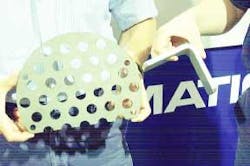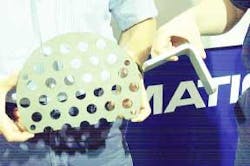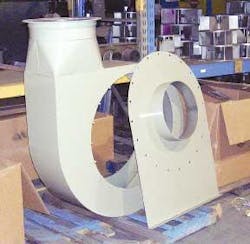Improving quality and processing time
TruCut Fabricators is a full-service metal fabricator utilizing value engineering and focused project management to deliver the highest-quality product at the lowest price. To accomplish these goals, the company periodically tests new products against existing ones to improve its fabricating processes.
In the area of CNC laser cutting, the company recently completed a test of the new Mate PEAK low-absorption laser lens against a lens it had previously used in its TRUMPF TLF 3 kW CO2 laser system, a machine for prototype, long, and short runs to fabricate components for industrial blower housings, transformer housings, electronic cabinetry, and general metal fabricating. Materials cut include 0.750 in. thick carbon steel, 0.500 in. thick stainless steel, and 0.187 in. thick aluminum and galvanized steel. The laser cuts material to size and produces various diameter holes and other part features. Hole consistency part-to-part is a key consideration in the company's laser operations.
"Getting consistent hole quality is important to us and our customers," reports Geoff Jones, laser production manager. "We pay careful attention to it because of the wide range of materials, thicknesses, and hole sizes that we work with. We constantly look for ways to improve our laser process quality and feed rates. When a Mate sales engineer proposed a four-week study, we decided it was worth a try."
Founded in 1992, TruCut Fabricators originally supplied precut steel components to its sister company, Sterling Blower, a manufacturer of pneumatic material handling systems and industrial fans. It expanded these capabilities to provide outsource fabricating to a wide range of OEM customers. In 1999, it moved into new, 60,000-square-foot facilities in Forest, Virginia, where it employs 60 full-time workers. The company now offers full-service metal fabrication including CNC laser cutting, CNC punching, CNC press brake forming, MIG, TIG, spot and stud welding, vibratory tumbling, straight graining, and rolling.
The company challenges its workers to find new and better ways to improve its quality and productivity as part of a continuous improvement program, and periodically examines each of its processes. On its TRUMPF laser, it was using a low-absorption lens following consistent maintenance procedures recommended by the lens and laser system manufacturer to achieve highest part quality while maximizing the life of the lens. The maintenance steps included a careful inspection of the lens and cleaning of the surface every 8 to 10 hours of operation with acetone and reagent grade polishing compound. Detailed records of these steps were kept for four weeks, first with the original lens, then for four additional weeks with the new Mate PEAK laser lens.
"The first thing we observed with the PEAK lens," Jones reports, "was that it was more resistant to buildup on the surface. We operated our other lens about 540 hours before buildup, and lens burn compromised the laser beam and required replacement. With the Mate PEAK lens, when we got to the 540-hour level, there were no signs of lens wear or lens burn. So, we continued to operate the laser with it. At the end of the four weeks, we reached 656 hours. That was a 22% improvement over the old lens. What's significant is that we continue to operate that PEAK lens far beyond the tested 656 hours without any indication of lens degradation or failure.
"The 3/8 and 1/4 in. hot rolled steel parts using the PEAK lens had better appearing edges than with the previous lens," reports Jones. "But the biggest improvement in higher-quality edges occurred on the 7 gauge hot rolled steel parts."
As for cutting speed, the improvements Jones reported were equally dramatic: 7 gauge hot rolled steel improved from 100 in./min to 115 in./min; 1/4 in. hot rolled steel improved from 52 in./min to 54 in./min (using N2); 1/4 in. hot rolled steel improved from 85 in./min to 90 in./min (using O2); and 5/16 in. hot rolled steel improved from 70 in./min to 81 in./min.
According to Jones, "The PEAK lens improved virtually all the hot rolled steel laser processing operations from thick to thin material. We eliminated less-than-desirable edges on 7 gauge and 1/4 in. thick parts. Holes overall were more consistent over the large (80x160 in.) cutting area of the laser system table. We've been very satisfied with Mate's PEAK lens."
For more information on TruCut Fabricators, visit www.trucutfabricators.com; on TRUMPF visit www.us.trumpf.com; and on MATE visit www. mate.com.


